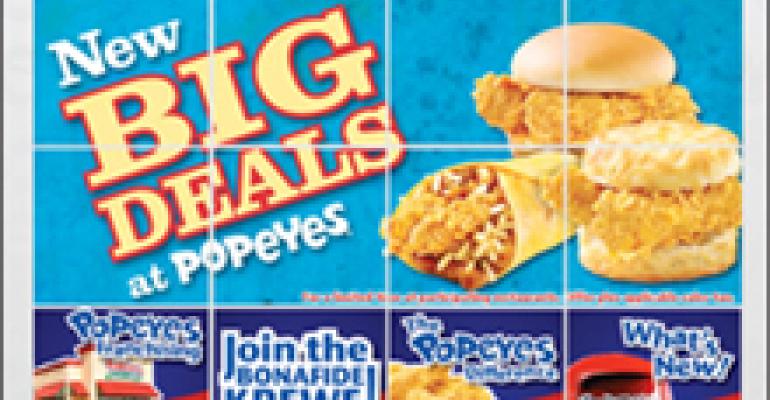Four meals under $4. Ten casual-dining dishes for $5.95 each. A 6-ounce sirloin and two sides for $9.99. Eleven meals at $5 each. It seems to be fire-sale time out there.
Concepts in all segments are introducing sharply lower price points on key menu items that executives hope will provide the value that today’s consumer demands amid cost inflation from creeping energy and grocery prices.
While operators say the off-price items are designed to boost sales and profit, pundits are questioning whether some of the dishes are dangled as zero-profit loss leaders to lure customers into restaurants in the hopes they will spend more money on conventionally marked-up products and add-ons like high-margin beverages or desserts.
Burger King successfully has employed this approach—what it calls a “barbell” menu strategy—to produce industry-leading sales trends. Its Value Menu has seen increased usage, chain officials said, but the regularly priced items like the Whopper or premium-priced items like the Steakhouse Burger garner customer attention, trial and increased sales.
“While [restaurant operators] say they would never launch an unprofitable item, you have to wonder at some of the recent price points,” said Bonnie Riggs, a restaurant analyst at the NPD Group, a foodservice market research firm in Port Washington, N.Y. “The strategy is to have a low-price-point offering, increase brand awareness, and then hopefully trade [the consumer] up or get them to add on items.”
Restaurant operators say they can have it both ways, with products that entice consumers and that make a profit.
“My goal is profitable traffic,” said Dick Lynch, chief marketing officer for Atlanta-based Popeyes. “It cannot be a paradox.”
At the 1,901-unit chicken chain, three new items under the chain’s Big Deals menu were introduced at $1.49. They are smaller, snack-sized items that include a chicken wrap, fried-chicken sandwich and chicken biscuit. The aim is to pick up traffic at snack and late-night dayparts, like other quick-service chains have done successfully.
Officials of Popeyes franchisor AFC Enterprises Inc. said the items also were designed with food costs in mind and meet margin requirements that franchisees can “withstand.”
Other quick-service brands offering value incentives include Arby’s, the 3,719-unit sandwich chain, which recently reintroduced its Pick 5 for $5.95 promotion. Customers can pick any five items in any combination from a menu of eight offerings.
Fast-casual chains like El Pollo Loco and Boston Market also are promoting lower-price deals. At Irvine, Calif.-based El Pollo Loco, a chain of about 409 restaurants, customers can choose from four meals under $4. Priced at $3.99, the meals include Citrus Marinated Flame Grilled Chicken, Crunchy Taco, Classic Chicken Burrito or Tacos Al Carbon with a choice of rice, pinto beans, or mashed potatoes and gravy. A drink is not included.
Golden, Colo.-based Boston Market introduced a $5 menu with 11 items at its 575 units. The menu includes a quarter rotisserie chicken with a side item and cornbread, a half rotisserie Chicken Carver sandwich with a side item and drink, and chicken pot pie.
The menu was designed as an incentive to new customers and a way to increase the frequency of loyal patrons, said Boston Market spokeswoman Angela Proctor.
“We are all very busy,” she said, “and while coupons and new offers are attractive, in this economy we wanted to make sure consumers know they can depend on Boston Market every day.”
The menu is a permanent edition and not a limited-time offer.
Outback Steakhouse in Tampa, Fla., also is looking to garner a larger share of everyday dining. The 976-unit casual-dining chain introduced in most markets a $9.99 6-ounce sirloin served with two side items. The deal was created to drive traffic to the struggling chain, especially during weeknights.
“We know our relative share of everyday occasions is very low,” said Outback parent OSI Restaurant Partners LLC’s chief financial officer, Dirk Montgomery. “We think that’s a huge opportunity for us. We need to incentivize those folks to increase their frequency.”
Outback said its lower pricing is part of a longer-term strategy to move its check average down, increase consumer traffic and compete not just for special-occasion dining. The entire menu is being re-engineered, company officials said, to increase the amount of lower-price options.
“The traffic that is needed to offset the decline in profit per check depends on the composition of the menu,” Montgomery said. “It is very early in the process, and we believe this strategy will work. We just need to perfect the formula.”
The BJ’s Restaurant and Brewhouse chain also is hoping to spur more everyday traffic with a new lunch menu with 10 items priced at $5.95, a ticket more suited to quick service or fast casual than casual dining.
The menu includes sliders with French fries, a mini one-topping pizza and salad, and fish or shrimp tacos. The new lunch menu is a permanent addition, said Matt Hood, chief marketing officer at BJ’s parent company BJ’s Restaurants Inc. in Huntington Beach, Calif.
The chain spent time engineering the right mix of food items that could make a profit at this price point. Others in casual dining also are pushing lunch menus in the $5 and $6 dollar range, like at Applebee’s and Chili’s.
“Variety was key in this offering,” Hood said. “It delivers value but also allowed us to spread the choices across the menu. That helps us on food costs so we’re not putting all our eggs in one basket.”
BJ’s also spent substantial time testing its new offerings to make certain that enough traffic would be generated to justify the reduced check average, Hood said.
“If it works for the guest, it will work for us,” he said. “Everything works when you have the traffic.”




